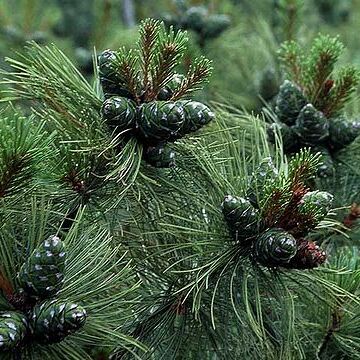Shrubs to 6 m tall, usually with creeping branches to 10 m; bark gray-brown, flaking; branchlets initially brown, dark red-brown in 2nd or 3rd year, densely pubescent; winter buds red-brown, conical-ovoid, slightly resinous. Needles 5 per bundle, trapeziform in cross section, 4-6(-8.3) cm × ca. 1 mm, stiff, vascular bundle 1, resin canals (1 or)2, marginal, base with sheath shed. Seed cones erect, maturing to pale purple-or red-brown, conical-ovoid or ovoid, 3-4.5 × 2.5-3 cm, indehiscent or imperfectly dehiscent at maturity. Seed scales broadly subrhombic or rhombic-obovate; apophyses broadly triangular, thick, swollen, margin slightly recurved; umbo purple-black, distinct, ending in a slightly recurved protuberance. Seeds dark brown, triangular-obovoid, 7-10 × 5-7 mm, wingless, abaxial margin ridged.
More
A shrub or small tree. It grows to 6 m tall. It has creeping branches to 10 m long. The bark is grey-brown and flaking. The small branches start brown but become reddish brown in the second and third year. They are densely hairy. There are 5 needles per bundle. They are 4-6 cm long by about 1 mm thick and stiff. The seed cones are erect. They mature to pale purple or red-brown. They are 3-4.5 cm long by 2.5-3 cm wide. The seeds are dark brown and triangle shaped. They are 7-10 mm long by 5-7 mm wide. They do not have wings.
An understorey plant in conifer forests in the lower parts of its range, often forming extensive thickets in exposed situations or above the tree line; at elevations up to 3,200 metres.
More
It is a temperate plant. It grows in the mountains between 1000-2300 m altitude in N China. It suits hardiness zones 5-9. In XTBG Yunnan.
Can be grown by cuttings or seedlings. Seeds needs soaking.



